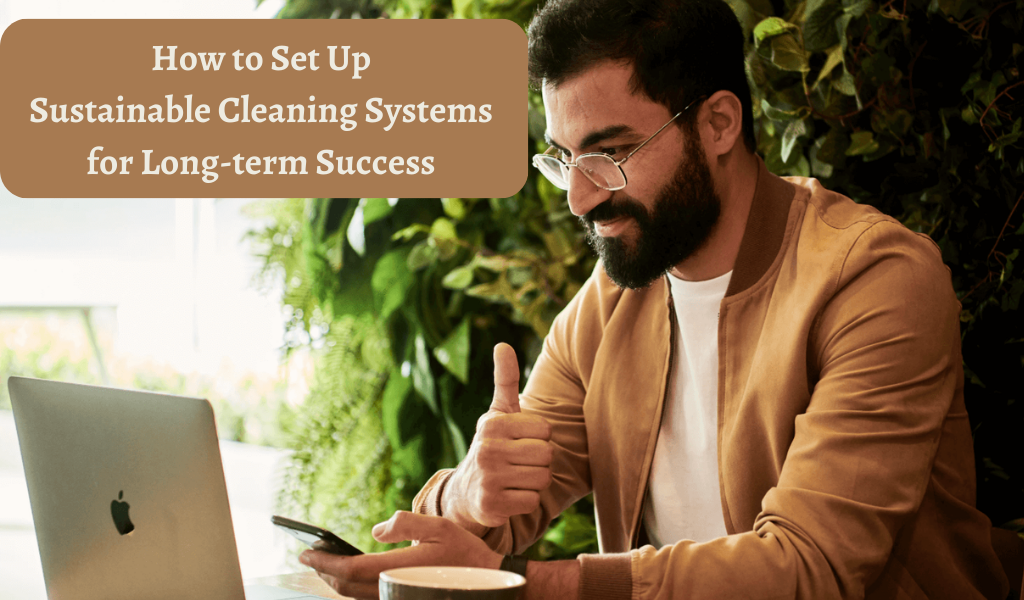Sustainable cleaning systems are the future of the future of the janitorial industry. Here’s how you can get on board now.
For a business, there was a time when sustainability meant higher supply costs on one side, with customers who didn’t want to pay higher prices on the other side. Unless you were in the right location with the right client base, setting up sustainable cleaning systems would make it difficult to turn a profit.
Not only would sustainable cleaning systems be expensive, but you would also have limited selections for both equipment and supplies. If you didn’t like what was available, you found yourself in a predicament.
Luckily, sustainable products and equipment have come a long way, even in the last several years. They are less expensive than they were, and many are on par with traditional cleaning chemicals. Plus, many customers are searching for sustainable and environmentally friendly cleaning companies, and they’re willing to pay a premium for the service.
Best of all, sustainable business practices can be exceedingly profitable. You often use less energy, less product, travel efficiently, and with safer cleaning products, you have a healthier janitorial team, which means fewer sick days. So, let’s take a look at how you can focus on sustainability in your company.
Ready to strengthen employee and customer relationships? Let’s start the conversation! Reach out today for more info.
8 Ways to turn sustainable cleaning systems into profitable realities
There’s more to sustainable cleaning systems than switching to green cleaning products. In fact, sustainability is an umbrella that can cover your entire business, from your people to your products. It requires some long-term thinking, but as a business owner, you probably already look well into the future.
If you have an existing business that you want to transition to fully sustainable practices, there might be some culture shock here. But remember, there’s more than one way to work toward sustainability. Even if you have to take things one step at a time, you’re still moving in the right direction.
Let’s look at several areas of your business and what sustainable cleaning systems might look like.
Products and supplies
We’ve looked at products and supplies in a few articles, which you can check out here and here. This is probably the area that most people focus on when they want to implement sustainable practices.
Changing your products and supplies is simple, generally doesn’t impact your bottom line too much, and is easy to see. Here are a few ways and reasons to implement sustainable practices in this area:
1. Order concentrates. Concentrates are often more expensive initially than ready-to-use products. However, when diluted properly, the unit price is substantially lower than RTU products. Not only is this a more economical approach, but concentrates require less packaging and less overall fuel for shipping.
2. Use green cleaning products (and check the labels!). Traditional chemical cleaning products can irritate the eyes, skin, and airways. The compounds impact indoor air quality, and they impact the environment both where the product is made and where you dispose of it. Green cleaning products often produce fewer volatile organic compounds (VOCs) and can be less irritating. Additionally, they are designed to limit the impact on the environment and wildlife. However! Beware of products simply labeled as “environmentally friendly,” “eco,” “natural,” “green,” etc. The absence of regulations means that any product can call itself “green.” Look for labels such as Safer Choice, DfE, or the Carpet and Rug Institute’s Green Label Plus.
Equipment
Investing in new equipment can be a big step in moving toward a business focused on sustainability. Here’s what to look for.
3. Look for the Seal of Approval. Along with cleaning products, the Carpet and Rug Insitute also certifies equipment with their Seal of Approval. CRI certifies extractors, vacuums, deep cleaning systems, and interim maintenance systems. They test for soil removal, dust containment, water extraction, and texture retention, among other factors to determine the efficacy of janitorial equipment.
4. Look for ergonomic design. Good ergonomic design can help prevent injuries and make it easier (and more efficient) for your team to do their job.
5. Bring in the robots. Robotic vacuums and floor cleaning machines may use cleaning solutions more efficiently than humans, and robots can free up your team to do more detailed work.
6. Maintain equipment. Well-maintained equipment lasts longer, works more efficiently, and keeps that material out of the landfill.
Administrative
Sustainable cleaning systems aren’t just about the products and equipment you use. The way you run your business can add to its sustainability.
7. Plan your routes efficiently. As you drive from one location to the next, an efficient route will save on gas, as well as wear and tear on your vehicle.
8. Track inventory. Carefully tracking your inventory can help you order more efficiently. You can also save on shipping costs with fewer orders.
There are numerous ways to ensure you run a sustainable cleaning business. These eight ideas will put you on the right path, but you don’t have to stop here. Feel free to explore your options and discover even more ways your cleaning business can be a leader in sustainability.
Make your cleaning business more organized, efficient, and profitable. Schedule a free call with Janitorial Manager to learn how mobile-friendly scheduling software can help you streamline your operation like never before.


